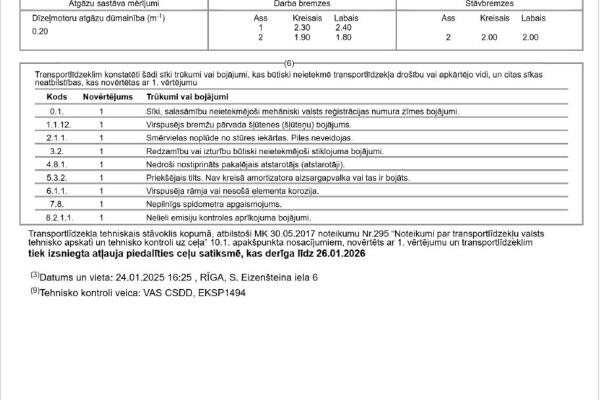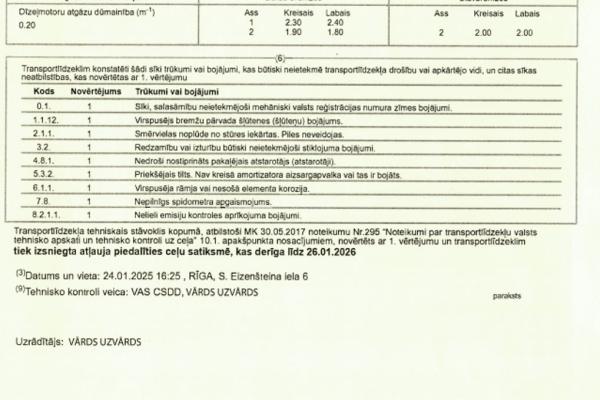General information
General overview
Roadworthiness of a vehicle is attested by a roadworthiness certificate and an entry in the State Register of Vehicles and Drivers.
Till December 31, 2024 roadworthiness testing stickers as proof of testing was attached to the lower right corner of the windshield.
Starting from January 1, 2025 roadworthiness testing stickers as proof of testing are no longer issued.
From this date, the confirmation that a vehicle has passed the state roadworthiness test and is authorized for road use will be recorded in the State Register of Vehicles and Drivers. Additionally, a roadworthiness certificate will be issued in paper and electronic format.
The electronic version of the roadworthiness certificate is available free of charge via the e-service at https://e.csdd.lv/chkta.
- Step 1: By entering the vehicle's registration number or VIN on this site, you can verify the validity period of the roadworthiness test.
- Step 2: By providing the vehicle's registration certificate number, you can obtain the electronic version of the roadworthiness certificate.
Test frequency
| Categories or types of Vehicles | First mandatory test | Subsequent tests |
|---|---|---|
| M1 | Within three years of the date of first registration | Every two years then every year after nine years after the date of first registration |
| Taxis | Within one year of the date of first registration | Every year then every six months after three years |
| M2, M3, driving-school vehicles | Within one year of the date of first registration | Within one year then every six months |
| N, O3, O4, ambulances | Within one year of the date of first registration | Every year |
| L3e, L4e, L5e, L7e, O1, O2 | Within two years of the date of first registration | Every two years |
Exemptions
All mopeds (L1e, L2e, L6e) and vehicles of historical interest manufactured before 01/01/1945.
Responsible authorities
The Road Traffic Safety Directorate (CSDD) is the competent testing authority in Latvia. Roadworthiness certificates are issued by roadworthiness test stations under the supervision of the CSDD.
Websites
https://www.csdd.lv/ (Latvian and main parts in English)
https://e.csdd.lv/chkta (Latvian and English)
Major changes
Starting from January 1, 2025, roadworthiness testing stickers as proof of testing are no longer issued.
Roadworthiness certificates are issued in paper and electronic format.
The test frequency for M1, O1, and O2 category vehicles has changed starting from January 1, 2025. Please refer to the table above in the "Test frequency" section for the updated testing intervals.


